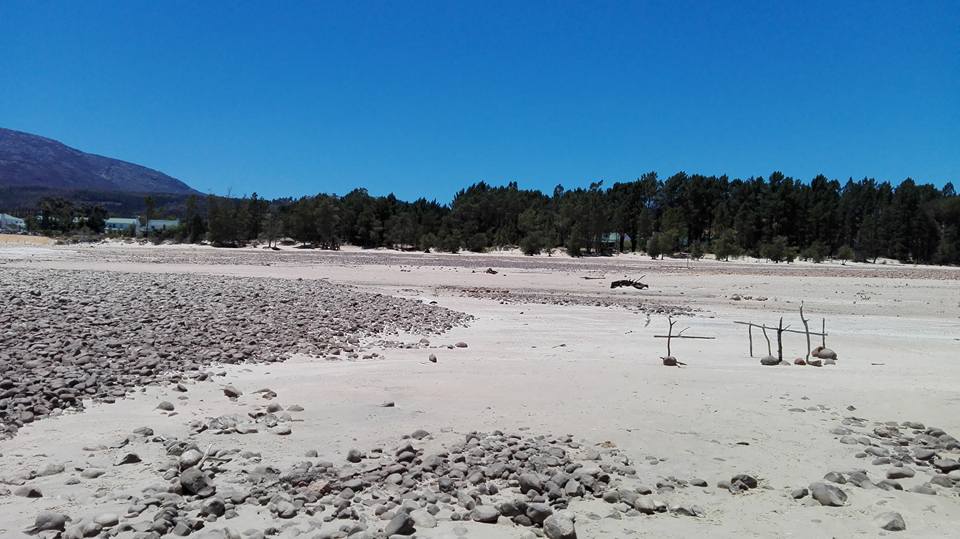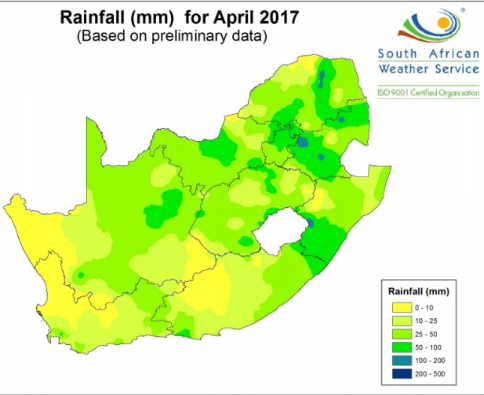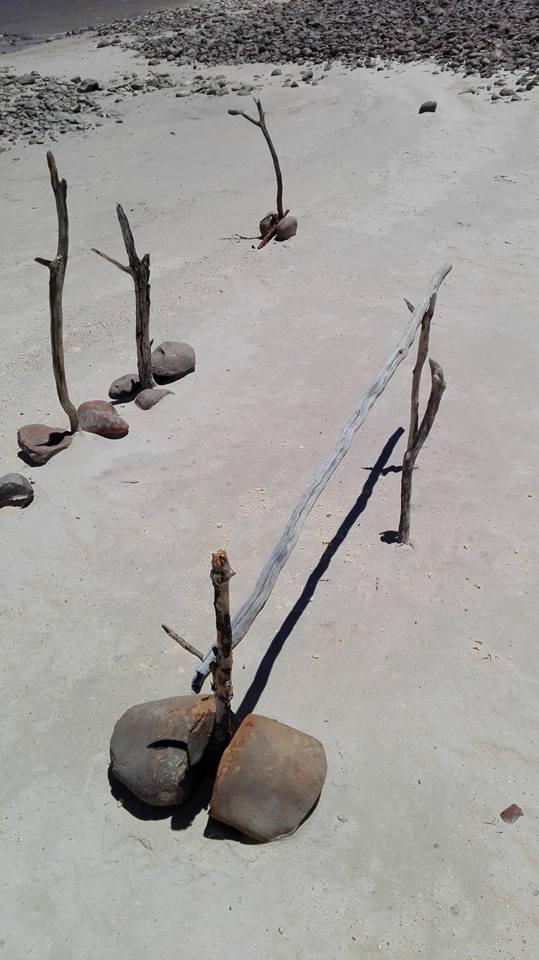Cape Town Water Crisis: the need to know basis

This picture was taken at Theewaterkloof dam – the main dam to provide fresh water to Cape Town – at the end of 2016. I have been visiting this area every year for over ten years. The first thing I noticed when I arrived in 2016 was how far away the water was. The photo was taken from the water’s edge. Usually, the water should be up to where the trees are. Since I posted the image over a year ago on Facebook, I would hate to know how the water crisis has impacted it now.
Many years ago, whenever I got my hands on a weekend newspaper, the first page I’d turn to was the one which displayed the level of the major fresh-water dams in South Africa by way of graph and percentage. I am unsure why I had such a fascination with it, but it may seem that later down the line, many of us have developed a great interest in the level of our dams [bar the few that continue to waste water – who in my opinion – deserve to be incarcerated].
Nevertheless, the Western Cape finds itself in quite a dry situation where, starting from the 1 February (2018), Cape Town will implement Level 6B water restrictions. Before we unpack what is included in the 6B guidelines, there are other matters to talk about it.
The infamous term “Day Zero” describes the day Cape Town can no longer officially provide fresh drinking water from their dams to its citizens and taps have to be switched off. This is due to the fact that the last 10% of dams is unusable. 12 April is only around the corner; at the time of release – 73 days away. This is a scary thought which is exasperated even further when one notes that Cape Town receives winter rainfall which predominantly only kicks off in the month of day zero itself – April and extends to September. In other words, according to the climate of Cape Town, the city can only start to expect any form of impressive rainfall when day zero arrives! This excludes the likelihood that Cape Town will not receive their average annual rainfall.

According to the South African Weather Services (SAWS), in April 2017, for the most parts of Cape Town it received only 10-25 mm of rain [picture taken from www.weathersa.co.za]
When day zero is breached, and the taps can no longer provide water, municipal water collection points will be in place where residents will have to collect their ration of 25-litres of water per day. This is half the amount that is stipulated in level 6B water restrictions. Keep in mind, you will have to wait in a long line, which is likely to be monitored by the police and perhaps even the army to collect a 25-litre portion of fresh water, which by the way, a shower takes roughly 8-litres of water per minute.

It was a bleak sight seeing the remains of water level indicators at the main dam which provides freshwater to Cape Town, Theewaterskloof Dam.
Since I have spent the last 3 months living and working in California, I have taken up interest in their national affairs. California have spent many years in as serious a drought as us. So what strategies can Cape Town implement from California to help relieve this water crisis?
California built extra reservoirs, expanding the total catchment area for when it eventually rained. Although this is not an immediate relief method, it is undoubtedly a permanently positive long-term investment.
A phrase was coined which coated up a lot of popularity, “showers to flowers”. Like Cape Town, California has a big agricultural sector – and this primary sector is severely struck by a drought. Therefore, waste residential water, “showers”, was recycled by treating it at water plants after which, the now potable water was piped to agricultural sites, “flowers”, such as farms, where the water was re-used to aid their daily functioning.
Improved storm water capture – all pipes, gutters, taps etc. need to be fixed. Not only for the sake of leaking taps, but because if old equipment breaks, that could result in the wastage of millions of litres of fresh water in a short period of time. Furthermore, the city needs to be fully prepared to capture every drop of fresh water for when it storms. The city must be able to prevent fresh water from gushing off back into the ocean. At the end of the day, however, is that if no rain arrives, all these implementations are somewhat useless. But that being said, the city needs to be fully ready for when that storm does hit! California has a population of 39.78 million and was in a serious drought for four years. Cape Town on the other hand has a population of 3.75 million and is currently in its third year of the drought. So there is definitely hope for us.
Let us now turn to examining the level 6B water restrictions (to be in place as of 1 February). The guidelines are once again not impressive. They lack direction and authority which is needed to resurrect us out of this drought. That being said, the major changes from level 6 to 6B are:
- 50-litres per person per day (as opposed to 87 L).
A whole lot of blah blah blah admin claiming you need signed paperwork such as “All boreholes and wellpoints must be registered with the City and must display the official City of Cape Town signage clearly visible from a public thoroughfare.”
Since 6B water restrictions are pretty serious – the government has now made it compulsory that people who own a private swimming pool must have a cover fitted! Governmental innovation at its absolute finest…
Non-residential areas and agricultural facilities are still meant to reduce their water usage by 45% and 60% respectfully (carried over from level 6). But please tell me, how are such drastic cuts meant to magically happen? I fully support such water saving and in fact commend the optimism – but the government needs to be playing a greater role in ‘HOW’ this will be done and not simply barking ‘WHAT’ needs to be done.
One needs to remember, and I am sorry to say it, Cape Town residents and companies have for the most parts, been pathetic with saving water – evident by the fact that day zero has been brought forward from April 29th. In other words, the city is in a position where we have DAYS left of fresh water, and the population is still not doing enough – and some are doing nothing!
Why are the 9 provinces of South Africa not united in helping resolve this catastrophe!? There are major dams in Gauteng, Free State and Kwazulu-Natal where dams are 90% full, or even over 100% capacity. Transport that water down to where it is needed, surely? The Cape Argus has highlighted such segregation but between local and national government:
“Western Cape Premier Helen Zille even went as far as calling on President Jacob Zuma to declare the water shortage in the province a national disaster. But nothing has come of this.” – in other words, Cape Town could be the first major city in the world to ever run dry of fresh drinking water; yet the national government is more than hesitant to assist?
One also needs to ask why the South African Weather Services (SAWS) hasn’t played a more domineering role in this Cape Town drought. Their field of expertise is meteorology – and the responsibility begins with them. This major drought originates [at least] 3 years ago, in 2015. Why is the city in a situation where desalination plants (machines which turn sea water into fresh drinking water) are only being erected now – which can only be used after the detrimental day zero?
Furthermore, I am fascinated to see how South Africans use social media to help the cause of saving water. When it comes to social media, I have one hope and that is that it is not used as an arena to spread memes about this problem. All I see on Facebook nowadays are memes, useless videos and “Tag a friend and say nothing”…Use the platforms for its original purpose and help spread awareness. In fact, I recommend joining the Facebook group called “Water Shedding Western Cape”.
If you feel strongly about the Cape Town water crisis and saving water to defeat day zero, network with me so that my next piece can be a podcast on this matter.
Now is not the time to sit back and sip on a Pina Colada. Get down and dirty with the rest of us!
Please share and comment on how you are saving water! Let’s innovate!
Next article: Saffers On Tour - Cold Welcome »




